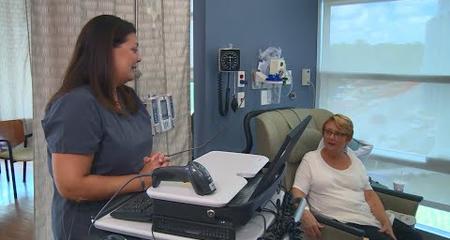Radiation oncologists use precisely directed beams of radiation to kill cancer cells or keep them from growing and dividing. Radiation therapy is a treatment option for many cancers.
External beam radiation techniques use a device called a linear accelerator to deliver high-dose X-rays to cancerous tissue. More and more, sophisticated image-guided systems allow radiation oncologists to "shape" the radiation dose exactly to outer limits of the tumor, delivering a higher dose of radiation with more precision and avoiding health tissues.
Intensity-Modulated Radiation Therapy
Intensity-modulated radiation therapy (IMRT) is a technique that delivers radiation treatment that conforms to the three-dimensional (3D) shape of a tumor while avoiding nearby organs that are at risk of receiving unnecessary radiation. It can be used to treat prostate cancer, head and neck cancers, gastrointestinal, gynecologic and lung cancers, and brain tumors.
With the help of 3D images from pre-treatment planning (CT, PET or MRI scans), the shape and direction of the radiation beams are arranged in multiple, "cross-firing beams." Each beam can be adjusted to provide a higher or lower dose of radiation. The radiation beams conform tightly to the tumor and its margins while minimizing the dose to normal tissues surrounding the tumor. Added together, the radiation dose from the multiple beams results in highly precise treatment. IMRT decreases common radiation therapy side effects such as fatigue, skin changes and hair loss. Side effects can vary depending on the part of the body treated.
Stereotactic Body Radiation Therapy
Stereotactic Body Radiation Therapy (SBRT) is a treatment technique that uses special equipment to position a patient and precisely deliver external radiation therapy to tumors in the body (except the brain).
TomoTherapy
TomoTherapy, a type of SBRT, is an advanced radiation therapy system that combines a unique spiral dose pattern with a built-in imaging unit. The spiral dose pattern enables the system to deliver radiation from hundreds of angles. The system's built-in CT scanner allows technicians to check the position of a tumor immediately before treatment, which gives physicians the flexibility to modify the treatment plan when tumors change in size or position. The Froedtert & MCW Clinical Cancer Center was one of the first cancer programs in the nation with the TomoTherapy system.
Gamma Knife
Brain tumors and vascular disorders account for the majority of radiosurgical procedures performed today. Radiosurgical treatment provided by the Gamma Knife is effective at controlling tumor growth, and hemorrhaging from vascular malformations. This treatment procedure targets lesions in the brain so exactly that the risk of harming healthy tissue is minimized. In certain cases, Gamma Knife treatment may serve as an adjunct to standard neurosurgical therapy or as the preferred course of treatment when further traditional therapy is not recommended.
Radioembolization
Radioembolization delivers a high dose of radiation directly to a liver tumor using a product called TheraSphere®. The procedure targets the cancer site with minimal effect on surrounding healthy tissues. The Froedtert & MCW Clinical Cancer Center was the first in Wisconsin to offer this treatment.
Recognized as High Performing by U.S. News & World Report
Froedtert Hospital is recognized by U.S. News & World Report as high performing in three adult specialties and 16 procedures and conditions, including cancer.
Blogs, Patient Stories, Videos And Classes





